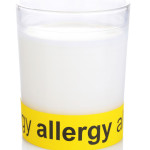 Many people may think they are allergic to milk, but in reality, only 1-3% of infants are actually born with a milk allergy, and most outgrow it by the time they are teenagers. A milk allergy is sometimes confused with lactose intolerance, which is very different from an allergy and is much more common.
Many people may think they are allergic to milk, but in reality, only 1-3% of infants are actually born with a milk allergy, and most outgrow it by the time they are teenagers. A milk allergy is sometimes confused with lactose intolerance, which is very different from an allergy and is much more common.
What is a milk allergy?
When a person has a milk allergy, their body’s immune system has a bad reaction to one or more of the proteins found in cow’s milk. Casein and whey are the most common milk-proteins that lead to a milk allergy.
What are some of the symptoms caused by milk allergy?
A milk allergy can cause:
- Skin reactions such as swelling of the lips, mouth, tongue, face, or throat
- Hives or a rash
- Itchy skin or eyes
- Respiratory problems such as sneezing, a runny nose, coughing or wheezing
- Asthma
Can any of these symptoms be dangerous?
The most serious reaction to milk allergy is called anaphylaxis (an-uh-fa-lak-sis). Anaphylaxis happens suddenly and involves dangerous changes to your breathing, heart rate, and other body functions. Anaphylaxis also occurse when several different symptoms occur together, such as getting a rash and wheezing, or stomach pain and swelling of the throat. Anaphylaxis usually happens within seconds to minutes of exposure to an allergen, such as milk, and is life-threatening without emergency medical treatment.
Is milk allergy the same as lactose intolerance?
No, milk allergy is different from lactose intolerance. Milk allergy is an allergic reaction to milk proteins, and lactose intolerance is the inability to digest the lactose sugar found in milk. The symptoms of lactose intolerance are usually diarrhea, cramping, and gas. If you have a milk allergy, do not consume lactose free products as they likely contain the milk protein you are allergic to.
Who can be allergic to milk?
A milk allergy can affect people of all races and ethnic groups. Most people develop milk allergy when they are infants and outgrow their allergy as they get older. A small number of people do not outgrow milk allergy and remain allergic to milk as adults. Milk allergy does not usually develop later in life.
How can I tell if I am allergic to milk?
Your health care provider can help you figure out if you have a milk allergy, or if your symptoms are from lactose intolerance. Finding out if you are truly allergic to a certain food can be hard. To make this task easier for you and your health care provider, it’s a good idea to keep track of the following information:
- What are your symptoms after eating or drinking foods that contain milk?
- How long does it take for you to get symptoms?
- Do you get symptoms every time you have a milk-containing food or drink?
- Do any of your relatives have a food allergy?
What can I do if I have an allergy to milk?
Plan ahead. Think about what you would do if you accidentally ate or drank a food that contained milk. Your health care provider can prescribe a drug called epinephrine that can stop the symptoms of an anaphylactic reaction and give you time to get to the hospital. You may have heard of an Epipen® which is the most commonly prescribed form of epinephrine. If you have severe reactions to milk, it is important for you to always carry an Epipen® or another form of epinephrine in case of emergency.
What else should I do if I am allergic to milk?
- Talk to a nutritionist. A nutritionist can help you figure out which foods might have milk in them. They can also help you find milk-free substitutes that will give you important nutrients such as calcium, vitamin D, and protein.
- Be careful when you eat out. Tell your server that you are allergic to milk and always ask about the ingredients in a menu item before you order it.
- Bring your own food. If you are going to be a guest at someone’s house, bring your own food just in case you can’t eat what the host prepares because it contains milk.
- Read food labels and stay up-to-date with food products. Every now and then food manufacturers change their labels. Even if you eat a certain product all of the time, remember that the ingredients can change.
- Avoid product labels that have the letter D in bold type. The D stands for dairy.
- Purchase deli meats with caution. Cross-contamination can occur when meats are sliced on the same equipment used to slice cheese. Prepackaged deli meats can also contain milk proteins in the brines that surround the meat. Most food manufacturers list a 1-800 number on the back of their products that you can call to find more information.
- Check out the Nutrition Facts label. It is a requirement that the Nutrition Facts label on all packaged foods must list if a food contains a common allergen such as milk. You can also double check that a food is safe by reviewing the ingredient list on the food label.
- Avoid the following milk-containing foods and ingredients:
- Artificial butter flavor
- Butter, butter fat, buttermilk
- Casein – milk protein
- Caseinates (ammonium, calcium, magnesium, potassium, sodium)
- Cheese, cottage cheese, curds
- Cream
- Custard, pudding
- Ghee – clarified butter
- Half and Half®
- Hydrolysates (casein, milk protein, protein, whey, whey protein)
- Lactoglobulin
- Lactose – sugar in milk
- Milk (derivative, protein, solids, malted, condensed, evaporated, dry, whole, low fat, non-fat, skim, and LactaidTM Milk)
- Non dairy creamer (check for casein)
- Nougat
- Rennet – used to curdle milk (may contain whey)
- Sour cream
- Sour cream solids
- Whey – milk protein (delactosed, demineralized, protein concentrate)
- Yogurt
- The following foods or ingredients may contain milk:
- Brown sugar flavoring
- Caramel flavoring
- Chocolate
- High protein flour (protein source could be skim milk powder)
- Lactic acid starter culture
- Margarine (may contain whey)
- Natural flavoring
- Simplesse® (could be made from eggs or milk protein)
- Protein shakes
- Protein bars
- Protein powder
- Foods with the following ingredients do not contain milk:
- Calcium lactate
- Calcium stearoyl lactylate
- Cocoa butter
- Cream of tartar
- Lactic acid
- Oleoresin
- Sodium lactate
- Sodium stearoyl lactylate
Source: Read Full Article





